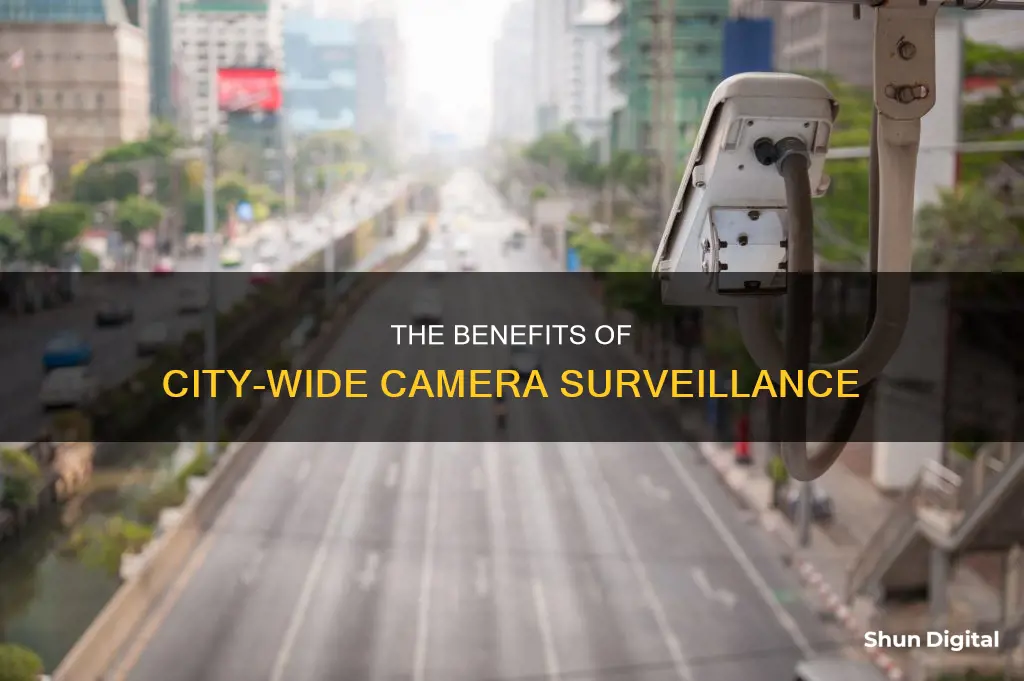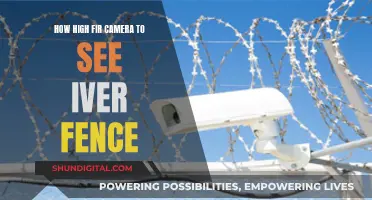
City-wide camera watch, also known as city-wide video surveillance, is a system of cameras installed in public spaces to monitor and enhance security, fight crime, and improve emergency response. These camera systems are typically deployed in cities to address safety concerns and improve the quality of life for citizens. The cameras are designed to work in both indoor and outdoor environments, capturing and recording video footage that can be monitored in real-time or reviewed later. This technology has been implemented in various cities, such as Denver, Colorado, and Baltimore, with the goal of reducing crime rates and improving public safety.
| Characteristics | Values |
|---|---|
| Purpose | To improve public safety and security, fight crime, and enhance collaboration between city agencies |
| Target Audience | Cities of all sizes, from mega-cities to "normal-sized" cities |
| Technology | Video surveillance cameras, license plate recognition, video management software, wireless networks, command and control systems |
| Funding | Private donations, asset forfeiture funds, federal grants, and city budgets |
| Privacy | Data privacy is ensured, and footage is only shared with law enforcement when necessary |
| Benefits | Reduce crime, improve traffic flow, enhance emergency response, and promote business growth |
| Challenges | High costs, complex technology, and the need for collaboration between multiple stakeholders |
What You'll Learn

Surveillance and analytics
Citywide camera surveillance systems are becoming increasingly popular and viable for cities of all sizes. They are a crucial tool for covering a wide array of services, such as traffic control, public security, and forensic investigation.
The implementation of these systems can vary depending on the city's size and resources. For example, the City of Longmont, Colorado, has successfully deployed a city-wide video surveillance system by using existing IP networks managed by the municipality and deploying NVR servers at various facilities. This allows for the storage and management of video footage from local cameras, reducing the bandwidth needed on the municipality's network.
Another example is the H.A.L.O. (High Activity Location Observation) system in Denver, which consists of 135 cameras recording imagery constantly and retained for 30 days. The system is funded through private donations, asset forfeiture funds, and federal grants. It has helped reduce crime by up to 45% and has been well-received by citizens.
To ensure the effectiveness of city-wide camera surveillance systems, several key principles should be considered:
- Use existing IP networks managed by the municipality to reduce costs.
- Deploy NVR servers at facilities to store and manage video footage, reducing bandwidth requirements.
- Establish direct wireless links from facilities to economically address outdoor locations needing surveillance.
- Share video footage with law enforcement agencies to help respond to emergencies and critical investigations.
- Expand the system gradually, year by year, to manage costs and build public support.
Additionally, city-wide camera surveillance systems can be enhanced by integrating with other technologies, such as license plate recognition software, audio recording capabilities, and video management software.
By following these principles and leveraging technology, cities can improve security, foster innovation, and provide countless opportunities for their citizens.
Cromebook Camera: Is Your Privacy at Risk?
You may want to see also

Safety and security
Citywide camera surveillance systems are becoming increasingly popular and effective in improving safety and security. These systems can be used to monitor and protect people, businesses, buildings, and infrastructure. They are also invaluable in preventing, mitigating, and investigating crime.
One of the key advantages of city-wide camera surveillance is its ability to provide real-time alerts and video analytics, enabling authorities to detect threats, identify suspicious activity, and respond quickly and efficiently. This was demonstrated in Denver, where a city-wide camera system helped reduce crime by up to 45%. Similarly, Detroit's Project Green Light, which connects video streams from businesses around gas stations to the police, resulted in a 50% reduction in violent crime in certain areas.
Another benefit of these systems is their ability to improve collaboration between different city agencies, such as the police, municipal governments, and transportation departments. For example, in Longmont, Colorado, the city-wide surveillance system integrates with the police department's command center, enabling them to access live or recorded video from any of the cameras deployed across the city. This not only helps in crime-fighting but also in coordinating responses to emergencies and natural disasters.
To ensure the effectiveness of city-wide camera surveillance systems, it is important to consider certain factors. These include the use of existing IP networks managed by the municipality, deploying NVR servers at each facility to store and manage video footage, and establishing direct wireless links from facilities to economically address outdoor locations that need surveillance. Additionally, it is crucial to have a broad base of integrated technology that can scale across multiple stakeholders and meet the changing needs of a city.
Overall, city-wide camera surveillance systems offer a powerful tool for improving safety and security in urban areas. By leveraging technology and collaboration between various stakeholders, cities can create safer and more vibrant communities for their citizens.
Monitor Your Camera Violation: A Step-by-Step Guide
You may want to see also

Public and private partnerships
City-wide camera surveillance systems are becoming increasingly popular, and they are a valuable tool for improving security and safety within a city. These systems can be established through public and private partnerships, with funding from a variety of sources, and by utilising existing infrastructure.
Another example of a successful public-private partnership is the City of Longmont, Colorado, which worked with Volpe Industries, Axis Communications, and Detexi Systems to develop a powerful city-wide surveillance solution. By utilising existing IP networks managed by the municipality, the city was able to keep costs low and build an effective surveillance system. This type of collaboration between public and private entities can result in a more efficient and cost-effective implementation of city-wide camera surveillance systems.
These partnerships also allow for the integration of multiple systems and the sharing of video footage between the city and the police department. This enables law enforcement to access live or recorded video from various locations across the city, aiding in emergency response and criminal investigations. Additionally, private businesses can benefit from these partnerships by having access to real-time crime-fighting tools and improved community policing, which enhances the safety of their customers and employees.
Furthermore, public and private partnerships can help address challenges related to safety, crime, and collaboration between stakeholders. By working together, cities can improve the quality of life for citizens, foster innovation, and create opportunities for economic growth. Through careful planning and collaboration, cities can make informed decisions about the future of their communities and ensure the continued success and safety of their citizens.
Frontier Watch: Camera-Equipped or Not?
You may want to see also

Real-time alerts and analytics
City-wide camera surveillance systems are becoming increasingly popular and accessible to cities of all sizes. These systems are a powerful tool for fighting crime and improving security, with the ability to provide real-time alerts and analytics that enhance public safety and enable better decision-making.
One example of a successful city-wide camera system is the H.A.L.O. (High Activity Location Observation) system in Denver, Colorado. This system has helped reduce crime by up to 45% in high-crime areas and has been well-received by the community. The program includes 135 cameras that record imagery continuously, with footage being retained for 30 days. The cameras are also integrated with the city's public schools and traffic cameras, providing additional benefits such as improved traffic management and coordination during emergencies.
Another key feature of city-wide camera systems is their ability to provide real-time alerts and analytics. For example, BriefCam's RESPOND platform enables users to trigger real-time alerts based on complex object classification and recognition filters. This technology can be applied to various situations, such as face and license plate recognition, line crossing, and monitoring people or vehicles of interest. By utilising advanced video analytics, systems like Alert 360 can differentiate between people, animals, and vehicles, ensuring that users receive tailored notifications that address their specific security concerns.
The effectiveness of city-wide camera systems can be further enhanced by integrating them with other smart city solutions. For instance, IoT-enabled smart cities can optimise waste collection routes and schedules by tracking waste levels in containers. Similarly, thermal camera monitoring can be used to detect overheating transformers and prevent costly failures. By combining camera systems with various sensors and analytics tools, cities can improve safety, optimise operations, and make more informed decisions.
Overall, city-wide camera systems offer a valuable tool for improving security and enhancing public safety. By providing real-time alerts and analytics, these systems enable authorities to make better decisions and respond more effectively to incidents as they unfold. As technology advances and becomes more accessible, we can expect to see more cities adopting and benefiting from these surveillance solutions.
Viewing Zmodo Cameras on PC: A Simple Guide
You may want to see also

Collaboration and integration
Citywide camera surveillance systems are becoming increasingly popular and accessible to cities of all sizes. They are a valuable tool in fighting crime and improving public safety, and they can also help with traffic control and forensic investigations. To be successful, these systems require collaboration and integration between various stakeholders, including municipal governments, law enforcement, businesses, and citizens.
One key aspect of collaboration and integration is ensuring that all relevant parties have access to the camera systems and the data they collect. This may involve sharing video footage and data with law enforcement, municipal governments, and other stakeholders. For example, in the City of Longmont, Colorado, the police department can access any of the NVR servers in the city to view live or recorded video, which has helped them respond to emergencies and solve crimes.
Another important consideration is the integration of different camera systems and technologies. This can include connecting private security systems with public surveillance cameras, as well as integrating with other smart city technologies such as sensors embedded in infrastructure. By combining multiple data sources, cities can improve their situational awareness and make more informed decisions.
In addition, collaboration between municipal governments, law enforcement, and businesses is crucial for successful citywide camera surveillance. For example, in the City of Detroit, the police department partnered with gas stations and other businesses to monitor video streams in real time, leading to a significant reduction in violent crime. This type of public-private collaboration can be highly effective in improving public safety.
To promote collaboration and integration, it is important to establish clear goals and objectives for the camera system that are aligned with the interests of all stakeholders. This may include improving public safety, reducing crime, and enhancing traffic management. By involving all stakeholders in the planning and decision-making process, cities can ensure that the camera system meets the needs of its citizens and contributes to a better quality of life.
Furthermore, technological advancements and innovations can play a significant role in facilitating collaboration and integration. For instance, the use of cloud-based systems and data-sharing platforms can enable different organizations to access and analyze camera data more efficiently and securely. This can streamline the process of sharing and analyzing information, leading to faster and more effective decision-making.
In conclusion, collaboration and integration are crucial aspects of successful citywide camera surveillance systems. By bringing together various stakeholders, sharing data and technology, and aligning goals and objectives, cities can improve public safety, reduce crime, and enhance the quality of life for their citizens.
Using Altec Lansing Cameras on PC: A Guide
You may want to see also
Frequently asked questions
A city-wide camera watch program is a surveillance system that uses cameras to monitor public spaces and infrastructure in a city. The cameras are typically installed in areas with high crime rates, and the footage is recorded and stored for a set period, for example, 30 days. The police force can then use the footage to help fight crime and improve public safety.
A city-wide camera watch program can help to reduce crime and improve public safety. The presence of cameras can act as a deterrent, and the footage can be used to investigate and solve crimes, leading to a quicker return on investment. Additionally, the cameras can aid in coordinating responses to natural disasters or man-made emergencies and can be used to monitor traffic and improve traffic flow.
A city-wide camera watch program typically involves installing cameras in public spaces, such as streets, intersections, and public buildings. The cameras are connected to a central repository, where footage can be stored and accessed by authorised personnel, such as the police force. In some cases, the cameras may be owned and operated by private businesses or residents, who agree to share the footage with the police when needed.







